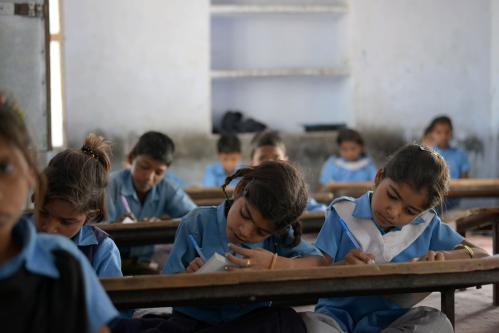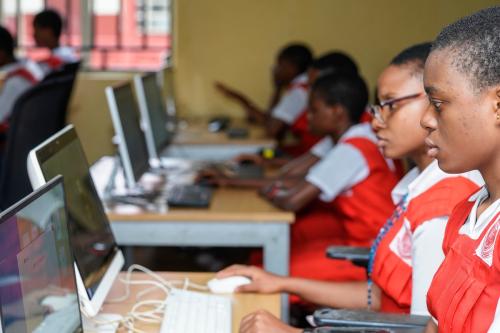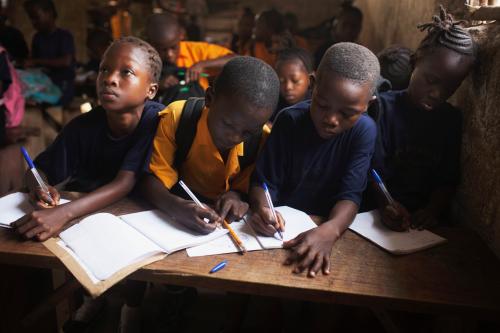Last Thursday morning, at a dark, early-morning hour, with my high-security badge securely hung from my neck, I cautiously trod along the slippery streets of Davos, Switzerland to participate in events at the 2018 World Economic Forum. This year, 2,500 of the world’s most powerful people gathered in this alpine town, with the aim of “Creating a Shared Future in a Fractured World”. Businesswomen and businessmen, world leaders, celebrities, entrepreneurs, the media, and academics like myself, met to discuss the pressing issues of today, including poverty, equality, climate change, terrorism, trade, and the refugee crises.
One of the big questions was how to fill the estimated $2.5 to 3 trillion annual investment gap needed to fulfill the 17 ambitious Sustainable Development Goals (SDGs), their 169 targets, and 230 indicators of success. Mind you, beyond finding the needed trillions of dollars, achieving these goals is no small feat. Goal 3, for example, aims to end preventable deaths of newborns and children under age 5. In the current scenario, 30 million newborns are expected to die between now and 2030. Goal 4, to ensure inclusive and quality education for all, is also a mighty task—given that, as things stand now, 263 million children and youth are out of school and the number is expected to grow. It will take a lot more than only money to address these issues.
Enter innovative financing for development. Innovative finance intends to both increase resources and improve the use of existing resources. One particular form of innovative finance, payment by results, or results-based financing, seeks to create incentives to achieve critical social outcomes by only paying when results are achieved. For over a decade, multilateral and bilateral donors have used variations of these tools as a way to bring transparency to development aid, with the end goal of improving more lives. The U.K.’s Department for International Development (DFID), for example, established the Global Partnership for Output-based Aid (GPOBA) in 2003 as a multi-donor trust fund administered by the World Bank, with the mandate of exploring output-based aid (OBA) projects across seven sectors. In addition, two other trust funds at the World Bank—focused on education and health—also use payment by results, as does the World Bank’s Program-for-Results (PforR) financing instrument.
But in recent years a new form of payment by results has come to the development stage and to this year’s discussions at Davos. Social and development impact bonds (SIBs and DIBs) draw on elements of impact investing or blended finance, as well as public-private partnerships and allow outcome funders (governments in SIBs and a third party, such as a donor agency or foundations, in DIBs) to pay directly for the achievement of outputs or outcomes, rather than for inputs or compliant behavior. They differ from traditional payment by results in that investors not only provide the upfront risk capital with an opportunity for return, but they also can play a critical role in helping to improve the system of service delivery by bringing private sector discipline into practices of monitoring and performance management. As of January 1, 2018, 108 impact bonds had been contracted across 25 countries, six of which are in developing countries.
Donor agencies like the World Bank, DFID, U.S. Agency for International Development (USAID), and the Inter-American Development Bank (IDB) have started to tread into this new territory. In Davos, I had the pleasure of moderating an event on the recently launched Utkrisht development impact bond (DIB) to tackle maternal and child mortality in Rajasthan, India. USAID Administrator Mark Green, who provided the keynote remarks, highlighted USAID’s commitment to using “new tools, partnerships and innovation” to address the SDGs, including dedicating $8 million in outcome funding to save over 600,000 lives. He also noted the potential for the model to bring “collaboration, co-financing, and co-designing” and the fact that taxpayers only pay when success has been achieved. Beyond this impact bond, the agency, through their Development Innovation Ventures (DIV) program, has used outcome-based financing to help households graduate out of poverty in Kenya and Uganda.
In another Davos gathering on development finance, heads of the major global donor institutions, ministers from developing countries, and business executives discussed bringing in more private capital and using new tools to spend resources more effectively. Mauricio Cardenas, Minister of Finance of Colombia, highlighted a recently launched social impact bond in his country, aimed at increasing employment among marginalized individuals. In this Colombian SIB, the first launched in a developing country, upfront risk capital is provided by local impact investors, who receive outcome payments from the Colombian government and the Swiss State Secretariat for Economic Affairs. This impact bond is in partnership with the IDB, which has taken a leadership role in the development of several impact bonds across Latin America. Though yet to be launched, the World Bank has also ventured into the world of impact bonds: one project aims to improve youth employability in the West Bank and Gaza, a second targets pre-term or low-birth-weight newborns in Cameroon, and a third for early childhood development in Uzbekistan. DFID is acting as the outcome funder in two of the five contracted DIBs so far, jointly with USAID in the project mentioned above in Kenya and Uganda, as well as an impact bond aimed at improving the lives of individuals injured in conflict (Nigeria, Mali, and the Democratic Republic of Congo) through adequate physical rehabilitation. Further discussions around the development of outcome funds or donor funds for specific sectors, such as education, are also underway among multiple donor agencies and foundations.
So what’s the big deal with these impact bonds? Are they just the flavor of the year? Perhaps there is indeed a bit of Kool-Aid drinking here. The idea of private capital and blended finance raises excitement about the possibility of filling that enormous financing gap. Based on our exploration of this tool over the last four years, however, we think there is something else there. It is about changing the entire system so that it works more effectively by investing in prevention, incentivizing collaboration, building a culture of monitoring and evaluation to drive performance management, and ultimately keeping everyone’s eye on the ball: focusing on the achievement of outcomes. These elements have the potential to truly make a dent in the SDGs by empowering countries themselves to lift themselves out of poverty and eventually ending the need for development assistance at all. For this to happen, however, domestic governments, national and subnational, must be an integral part of these new outcome-based financing arrangements.







Commentary
From Davos: Is paying for results with blended finance ready to take off?
February 1, 2018